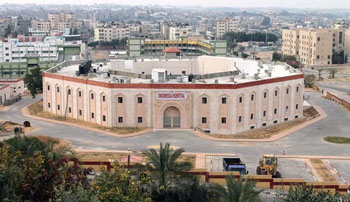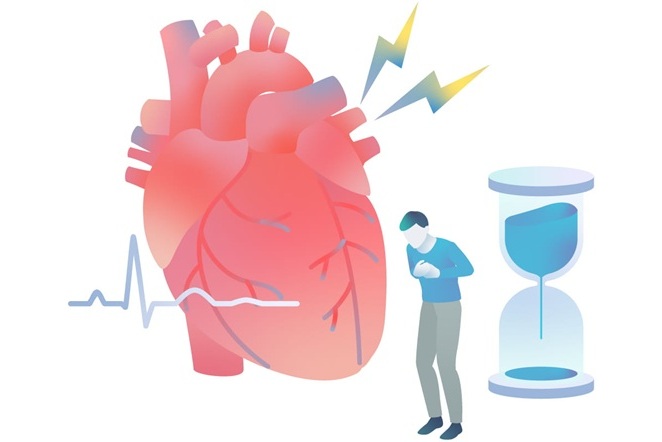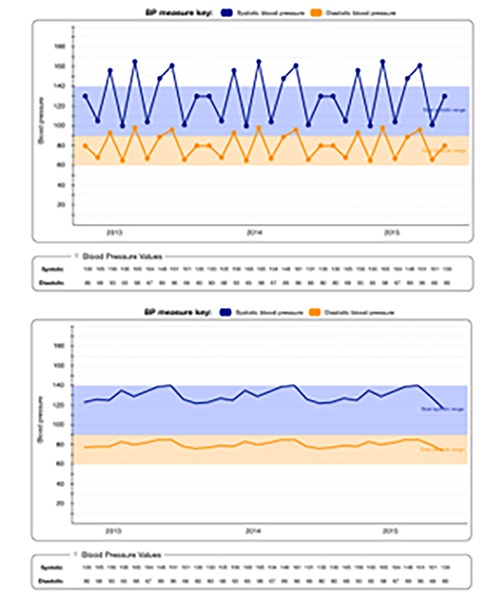Indonesia Hospital Opens in Gaza Strip 
|
By HospiMedica International staff writers Posted on 11 Apr 2016 |

Image: The new Indonesia Hospital in Northern Gaza strip (Photo courtesy of MER-C).
A new hospital funded by the people of Indonesia has been officially opened in the Gaza Strip, after a five-year construction effort.
The hospital is built on 16,000 m2 of land donated by the government of Gaza on a hill near Jabaliya, Gaza’s largest refugee camp. With 100 ward beds, four highly equipped operating theatres (ORs), and a 10-bed intensive care unit (ICU), it is the largest medical facility in northern Gaza, and will offer general and specialist abdominal care, and will also be home to Gaza’s only modern computerized tomography (CT) scanner. It is staffed by Gazans, helped by a few Indonesian volunteers.
Built at a cost of USD 8.7 million funded by Indonesia’s Medical Emergency Rescue Committee (MER-C; Jakarta, Indonesia), the octagonal, three-story Indonesia hospital will replace Kamal Adwan hospital, which has been closed down for renovations and maintenance. The Palestinian ministry of health will now renovate Kamal Adwan Hospital to improve the quality of its services, and during this period, medical services for children will be temporarily available in other hospitals in Gaza, including al-Nasr, al-Durra, Bait Hanoun, and Balsam hospitals.
“I would like to thank the people and the government of Indonesia for all of their help they have given in helping the people of Gaza,” said Dr. Mufeed Mukhalat, Health Minister of Palestine in Gaza.
“Indonesia Hospital would serve as the main hospital in Gaza, and it would also serve as the main center in delivering aids to the people of north Gaza.”
“This project is the proof of hard work and great collaboration. This is the result of collaboration, helping one another and involving every element available on the Gaza strip,” said Dr. Naji Sarhan, deputy minister of public works of Palestine in Gaza. “Indonesia Hospital as a mandate from the people of Indonesia to the people of Palestine would be one of the biggest hospital on the Gaza strip, even in the whole Palestine. Indonesia Hospital would also be the main hospital in north Gaza.”
The Indonesia Hospital will be joined in late 2016 by the Turkish-Palestinian Friendship Hospital, built at a projected cost of USD 34 million, and a Qatari-funded clinic specializing in fitting prosthetic limbs.
Related Links:
Medical Emergency Rescue Committee
The hospital is built on 16,000 m2 of land donated by the government of Gaza on a hill near Jabaliya, Gaza’s largest refugee camp. With 100 ward beds, four highly equipped operating theatres (ORs), and a 10-bed intensive care unit (ICU), it is the largest medical facility in northern Gaza, and will offer general and specialist abdominal care, and will also be home to Gaza’s only modern computerized tomography (CT) scanner. It is staffed by Gazans, helped by a few Indonesian volunteers.
Built at a cost of USD 8.7 million funded by Indonesia’s Medical Emergency Rescue Committee (MER-C; Jakarta, Indonesia), the octagonal, three-story Indonesia hospital will replace Kamal Adwan hospital, which has been closed down for renovations and maintenance. The Palestinian ministry of health will now renovate Kamal Adwan Hospital to improve the quality of its services, and during this period, medical services for children will be temporarily available in other hospitals in Gaza, including al-Nasr, al-Durra, Bait Hanoun, and Balsam hospitals.
“I would like to thank the people and the government of Indonesia for all of their help they have given in helping the people of Gaza,” said Dr. Mufeed Mukhalat, Health Minister of Palestine in Gaza.
“Indonesia Hospital would serve as the main hospital in Gaza, and it would also serve as the main center in delivering aids to the people of north Gaza.”
“This project is the proof of hard work and great collaboration. This is the result of collaboration, helping one another and involving every element available on the Gaza strip,” said Dr. Naji Sarhan, deputy minister of public works of Palestine in Gaza. “Indonesia Hospital as a mandate from the people of Indonesia to the people of Palestine would be one of the biggest hospital on the Gaza strip, even in the whole Palestine. Indonesia Hospital would also be the main hospital in north Gaza.”
The Indonesia Hospital will be joined in late 2016 by the Turkish-Palestinian Friendship Hospital, built at a projected cost of USD 34 million, and a Qatari-funded clinic specializing in fitting prosthetic limbs.
Related Links:
Medical Emergency Rescue Committee
Latest Hospital News News
- Nurse Tracking System Improves Hospital Workflow
- New Children’s Hospital Transforms California Healthcare
- Noisy Hospitals Face Threat of Decreased Federal Compensation
- Orthopedics Centre of Excellence Planned for Guy’s Hospital
- Research Suggests Avoidance of Low-Value Surgical Procedures
- U.S. Federal Readmission Fines Linked to Higher Mortality
- Columbia China to Build New Hospital in Jiaxing
- Dubai Debuts Second Robotic Pharmacy Service
- Seattle Hospital Network Shifts Away from Overlapping Surgeries
- ACC to Launch Valvular Heart Disease Program in China
- Mortality Rates Lower at Major Teaching Hospitals
- South Australia to Inaugurate Upscale Hospital
- Raffles to Launch Second Hospital Project in China
- Research Center Tackles Antimicrobial Drugs Challenge
- Miami Cardiac & Vascular Institute Completes Expansion Project
- Hospital Antibiotic Policies Improve Prescription Practices
Channels
Critical Care
view channel
Breakthrough AI Technology Accurately Assesses Heart Failure Severity
Heart failure (HF) is a complex condition where the heart cannot effectively pump blood to meet the body’s needs due to underlying medical issues. It is marked by recurring episodes and frequent hospitalizations.... Read more
New Approach to Visualizing Blood Pressure Data Can Help Better Manage Hypertension Patients
Sometimes, a patient’s blood pressure may be elevated in a doctor's office but normal at home, a phenomenon known as white coat hypertension. It is estimated that 10% to 20% of high blood pressure diagnoses... Read moreSurgical Techniques
view channel
DNA Origami Improves Imaging of Dense Pancreatic Tissue for Cancer Detection and Treatment
One of the challenges of fighting pancreatic cancer is finding ways to penetrate the organ’s dense tissue to define the margins between malignant and normal tissue. Now, a new study uses DNA origami structures... Read more
Pioneering Sutureless Coronary Bypass Technology to Eliminate Open-Chest Procedures
In patients with coronary artery disease, certain blood vessels may be narrowed or blocked, requiring a stent or a bypass (also known as diversion) to restore blood flow to the heart. Bypass surgeries... Read more
Intravascular Imaging for Guiding Stent Implantation Ensures Safer Stenting Procedures
Patients diagnosed with coronary artery disease, which is caused by plaque accumulation within the arteries leading to chest pain, shortness of breath, and potential heart attacks, frequently undergo percutaneous... Read more
World's First AI Surgical Guidance Platform Allows Surgeons to Measure Success in Real-Time
Surgeons have always faced challenges in measuring their progress toward surgical goals during procedures. Traditionally, obtaining measurements required stepping out of the sterile environment to perform... Read morePatient Care
view channel
Portable Biosensor Platform to Reduce Hospital-Acquired Infections
Approximately 4 million patients in the European Union acquire healthcare-associated infections (HAIs) or nosocomial infections each year, with around 37,000 deaths directly resulting from these infections,... Read moreFirst-Of-Its-Kind Portable Germicidal Light Technology Disinfects High-Touch Clinical Surfaces in Seconds
Reducing healthcare-acquired infections (HAIs) remains a pressing issue within global healthcare systems. In the United States alone, 1.7 million patients contract HAIs annually, leading to approximately... Read more
Surgical Capacity Optimization Solution Helps Hospitals Boost OR Utilization
An innovative solution has the capability to transform surgical capacity utilization by targeting the root cause of surgical block time inefficiencies. Fujitsu Limited’s (Tokyo, Japan) Surgical Capacity... Read more
Game-Changing Innovation in Surgical Instrument Sterilization Significantly Improves OR Throughput
A groundbreaking innovation enables hospitals to significantly improve instrument processing time and throughput in operating rooms (ORs) and sterile processing departments. Turbett Surgical, Inc.... Read moreHealth IT
view channel
Printable Molecule-Selective Nanoparticles Enable Mass Production of Wearable Biosensors
The future of medicine is likely to focus on the personalization of healthcare—understanding exactly what an individual requires and delivering the appropriate combination of nutrients, metabolites, and... Read more
Smartwatches Could Detect Congestive Heart Failure
Diagnosing congestive heart failure (CHF) typically requires expensive and time-consuming imaging techniques like echocardiography, also known as cardiac ultrasound. Previously, detecting CHF by analyzing... Read moreBusiness
view channel
Expanded Collaboration to Transform OR Technology Through AI and Automation
The expansion of an existing collaboration between three leading companies aims to develop artificial intelligence (AI)-driven solutions for smart operating rooms with sophisticated monitoring and automation.... Read more

















